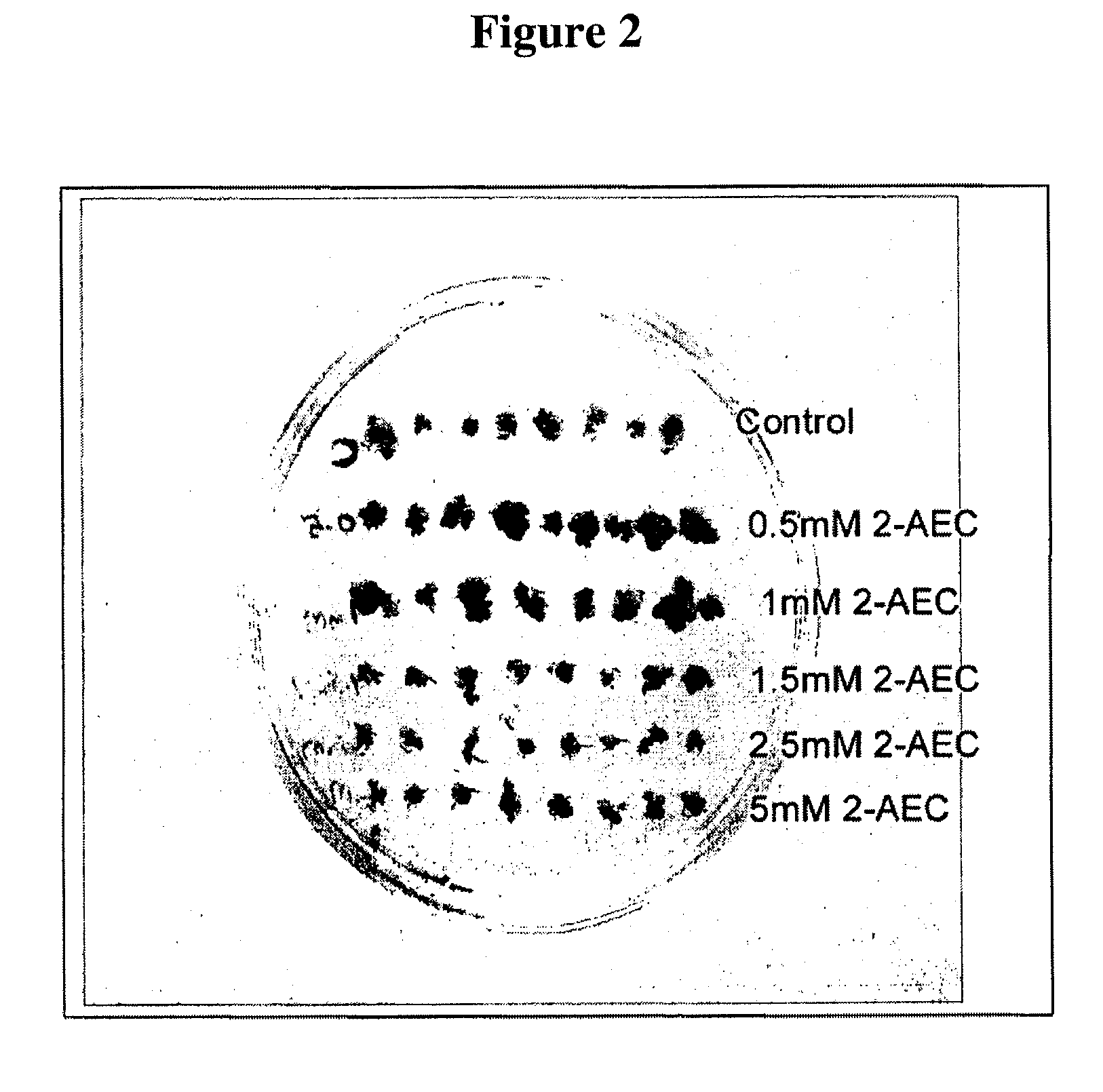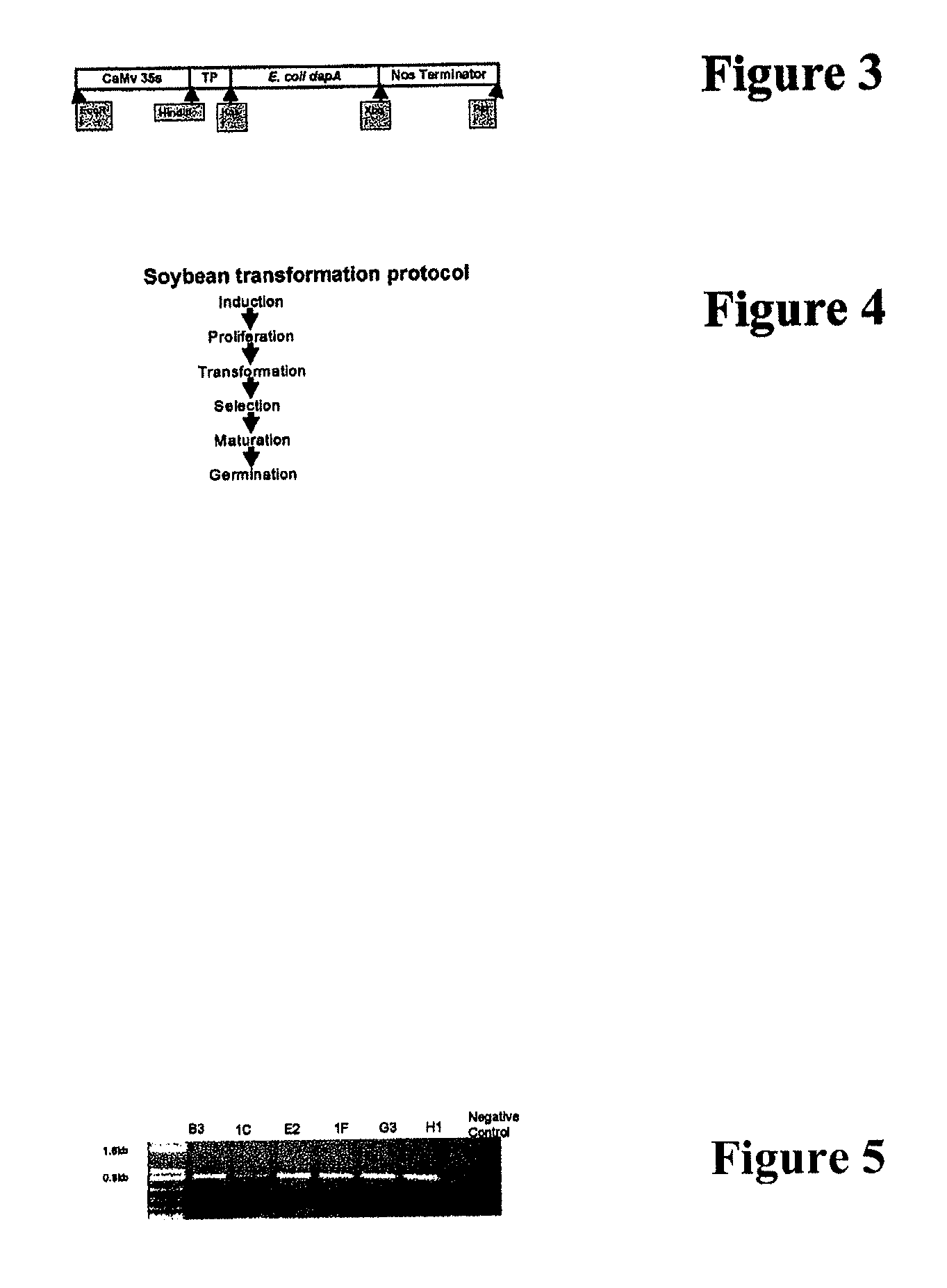Soybean selection system based on AEC-resistance
a selection system and soybean technology, applied in the field of soybean selection system based on aecresistance, can solve the problems of limited number of non-antibiotic resistance markers available, general inability to use, and time-consuming existing processes, and achieve the effect of improving soybean characteristics
- Summary
- Abstract
- Description
- Claims
- Application Information
AI Technical Summary
Benefits of technology
Problems solved by technology
Method used
Image
Examples
example 1
[0078]As a first step in the selection, different concentrations of AEC were used to see if it can kill the proliferating soybean somatic embryos as well as tobacco leaves and germinating tobacco and soybean seeds and germinating soybean somatic embryos. The effect of AEC is clearly seen in all these cases with varying concentrations. 100 μm AEC is sufficient to completely inhibit the germination of soybean somatic embryos whereas for germinating soybean seeds and tobacco seeds 2.5 mM AEC is required. For proliferating soybean somatic embryo concentrations up to 1 mM AEC is needed along with 0.0075% methylated seed oil to kill them. To further confirm that AEC is acting on the above mentioned tissues, the E. coli DHDPS gene was cloned and put into the binary vector p1201 with the pea RBCs transit peptide under the CaMV 35S promoter.
[0079]Proliferating soybean somatic embryos were shot with a gene gun using the E. coli DHDPS gene construct and the embryos were selected on both solid ...
example 2
[0080]Lysine-Threonine and Lysine-Analog S-(2-aminoethyl)-L-cysteine as Alternative Non-Antibiotic Selection System for Soybean Somatic Embryos.
Introduction
[0081]Plant cells and tissues are normally killed by exposure to S-2-aninoethyl-cysteine (AEC), which prevents lysine synthesis through inhibition of the plant enzyme dihydrodipicolinate synthase (DHPS). E. Coli DHPS is not inhibited by AEC. A vector for producing transgenic soybean plants encodes E. Coli DHPS. Soybean cells and tissues that are successfully transfected with the vector can be identified by exposure to AEC, which kills cells and tissues not containing the gene encoding E. Coli DHPS.
Procedure
[0082]An AEC selection system for soybean seeds with precise genetic changes and model system seeds (for rapid system validation) were germinated on 2 mM and 5 mM AEC containing agar plates. On the control plates without AEC all the seeds germinated, however only ˜10% of the soybean seeds germinated on 2 mM AEC plates and none ...
example 3
[0095]
SEQ ID No. 1:ctttggactctgaagctatgatgacttggtgaatatgcagattggacaaggggctgaaggtgttattgttggtgggacaactggtgaaggccaattaatgagccgggaagagcacataatacttattgctcatacagtcaactgttttggtgggaaaattaaggttattggaaatactggaagcaactccaccagggaagcaattcatgccactgagcagggttttgctgttggaatgcatgctgcccttcacataaacccttactatggcaaaacctccttggatggtatggttgctcactttcgaagtgtgctttccatgggacccacaataatctacaatgtgcctgcacggaccggacaagacattcctccgcatgtaattcaaaccttagctgaaagtgttaacctggctggtgtcaaggagtgtgtgggaaatgaccgaatcaaacagtatacagatgatggaattgttgtgtggagtgggaatgatgatcaatgtcatgatgctagatggggttatggggctaccggagtggtatctgttgcgagcaacctggttcccggtttaatgcgagaactcatgtttggcggtgtaaaccctactctaaattctaaactcttgcctctgattgactggcttttccacatgccaaaccccatnggtttgaacactgctcttgctcaacttggggncatc
[0096]The above sequence was derived from the wild-type soybean sequence encoding the polypeptide of SEQ ID NO:4. The nucleotide sequence shown as SEQ ID NO:1 corresponds to sequences encoding the polypeptide of SEQ ID NO:5, a genetically altered AEC resistant DHPS sequence der...
PUM
| Property | Measurement | Unit |
|---|---|---|
| concentrations | aaaaa | aaaaa |
| amino acid compositions | aaaaa | aaaaa |
| resistance | aaaaa | aaaaa |
Abstract
Description
Claims
Application Information
 Login to View More
Login to View More - R&D
- Intellectual Property
- Life Sciences
- Materials
- Tech Scout
- Unparalleled Data Quality
- Higher Quality Content
- 60% Fewer Hallucinations
Browse by: Latest US Patents, China's latest patents, Technical Efficacy Thesaurus, Application Domain, Technology Topic, Popular Technical Reports.
© 2025 PatSnap. All rights reserved.Legal|Privacy policy|Modern Slavery Act Transparency Statement|Sitemap|About US| Contact US: help@patsnap.com



